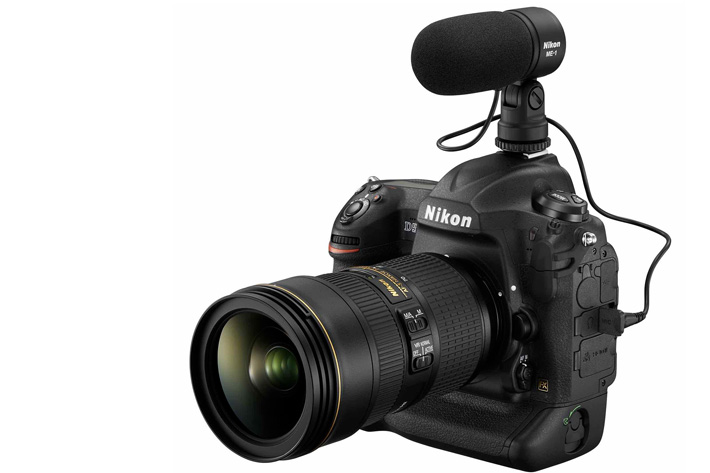
Nikon’s new firmware for their FX-format top of the line DSLR, the Nikon D5, introduces new options for video, and not just the change from 3-minute clips to the 29 minutes 59 seconds that are the normal capture time for many of these cameras.
One of the new options is the introduction of an Electronic VR function to the choices available on the Movie Shooting Menu. This effectively reduces the effects of camera shake with hand-held recording of movies in the FX- or DX-based movie formats. The effects of camera shake in three directions — vertical (up and down), horizontal (left and right), and rotational (around the center of the lens) — are reduced. This function is effective when recording movies in places or situations in which use of a tripod is prohibited or inconvenient, or when there simply isn’t time to set one up. In addition, Electronic VR can be used in combination with the optical vibration reduction (VR) built into a Nikkor lens for more effective reduction of the effects of camera shake.
It should be noted, though, that electronic vibration reduction is not available at frame sizes of 3840×2160 or 1920×1080 crop, and that the angle of view is slightly reduced when electronic vibration reduction is in effect. The effects of Electronic VR are also reflected when photos are captured during movie recording (Live frame grab).
The feature that most will appreciate, though, is the extended recording time. Movies up to 29 minutes 59 seconds in length can now be recorded at all movie quality and frame size/frame rate settings. The new firmware increases the maximum recording time of 4K UHD (3840×2160) movies from the 3 minutes present on the D5 at launch. Movies are recorded to up to eight separate files, each of which has a file size of up to 4 GB. Separate movie files can be combined to create a single movie using ViewNX-Movie Editor, of which Nikon just launched a new version, 1.2.2. One curiosity that may leave some worried: with the new firmware for Nikon D5 the maximum recording time for 4K UHD time-lapse movies is 3 minutes.
Flicker reduction for still images was added for more stable exposure under lighting that flickers. This is something of a trend with new cameras, so Nikon has implemented it on the D5. When shooting under fluorescent and some other types of artificial lighting, flickering may cause uneven exposure in parts of images and/or variations in exposure and color reproduction characteristics between individual images captured continuously or in quick succession.
Nikon equipped the new firmware with a Flicker reduction function for still images (captured during viewfinder photography, the function is not available with mirror up mode) that reduces these effects. When Flicker reduction is enabled, the camera detects peak brightness as light flickers and automatically times shutter release with these peaks in brightness for stable exposure and color reproduction characteristics. This function is effective when continuous shooting is used for indoor sporting events or similar situations captured at fast shutter speeds, although the continuous shooting rate may decrease.
https://www.youtube.com/watch?v=iBl8rtKN3lk
The last change introduced by the new firmware is the 9-point dynamic-area. The Nikon D5 originally supported 25-point, 72-point and 153-point dynamic-area AF. A 9-point dynamic-area AF option has been added with the new firmware. This new option is effective for focusing on a more specific portion of a moving subject. It also suggests that, sometimes, less AF points is better.
With dynamic-area AF, the camera focuses based on information from surrounding focus points if the subject briefly leaves the focus point selected by the photographer. In dynamic-area AF with 9, 25 or 72 points, the number of focus points actually used may be fewer than 9, 25 or 72, depending on the selected primary focus point. Extending the options to a lower starting number allows for what seems to be a more precise control of the area of focus.
The new firmware, C: Ver.1.10, for the Nikon D5 is available for download free of charge. The new version of ViewNX-Movie Editor, 1.2.2, can also be downloaded following the link.
